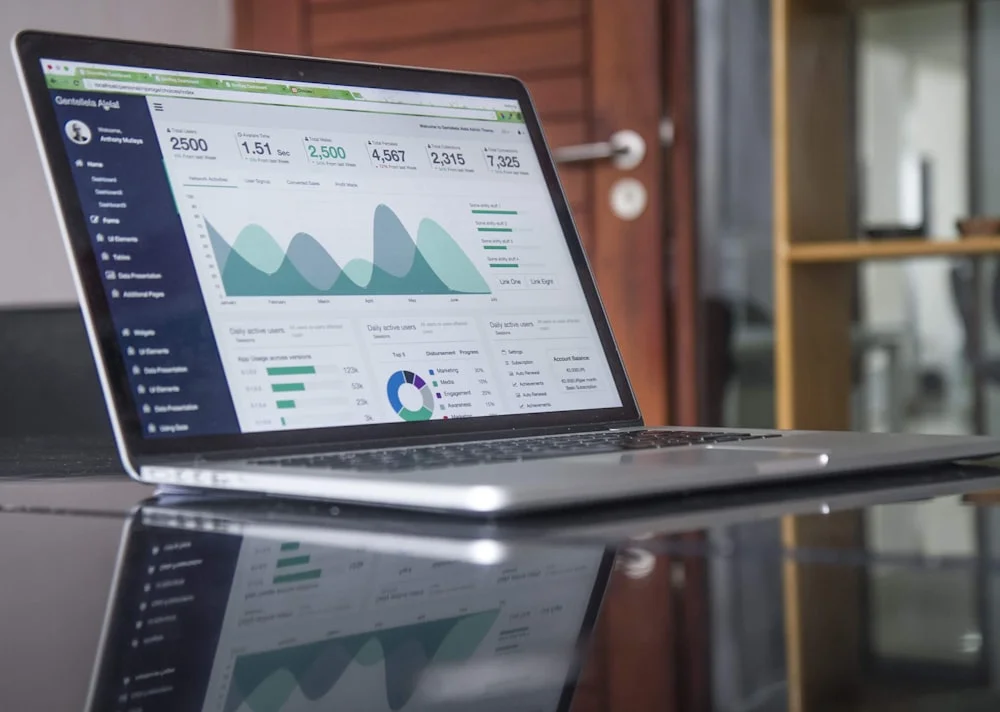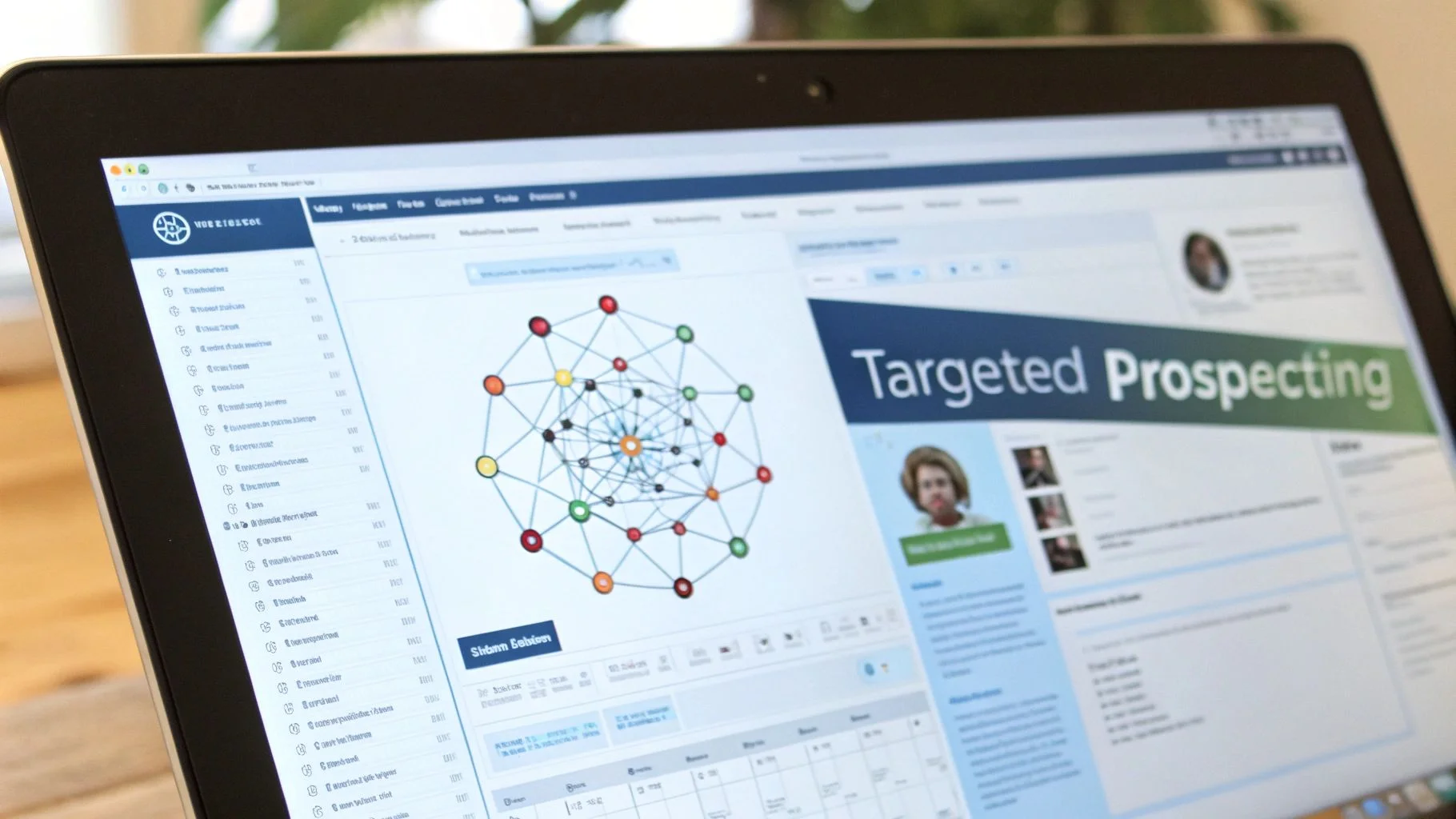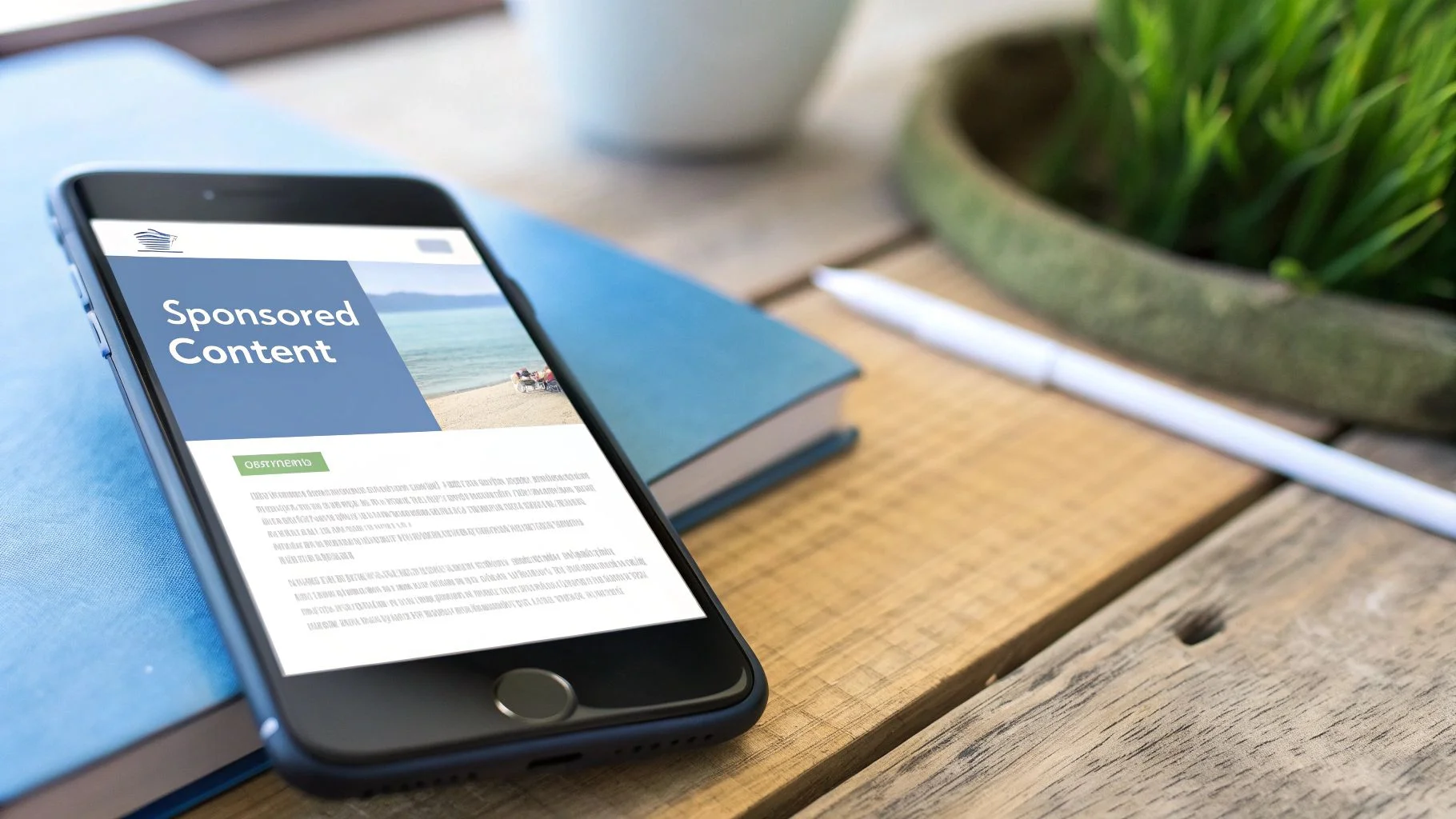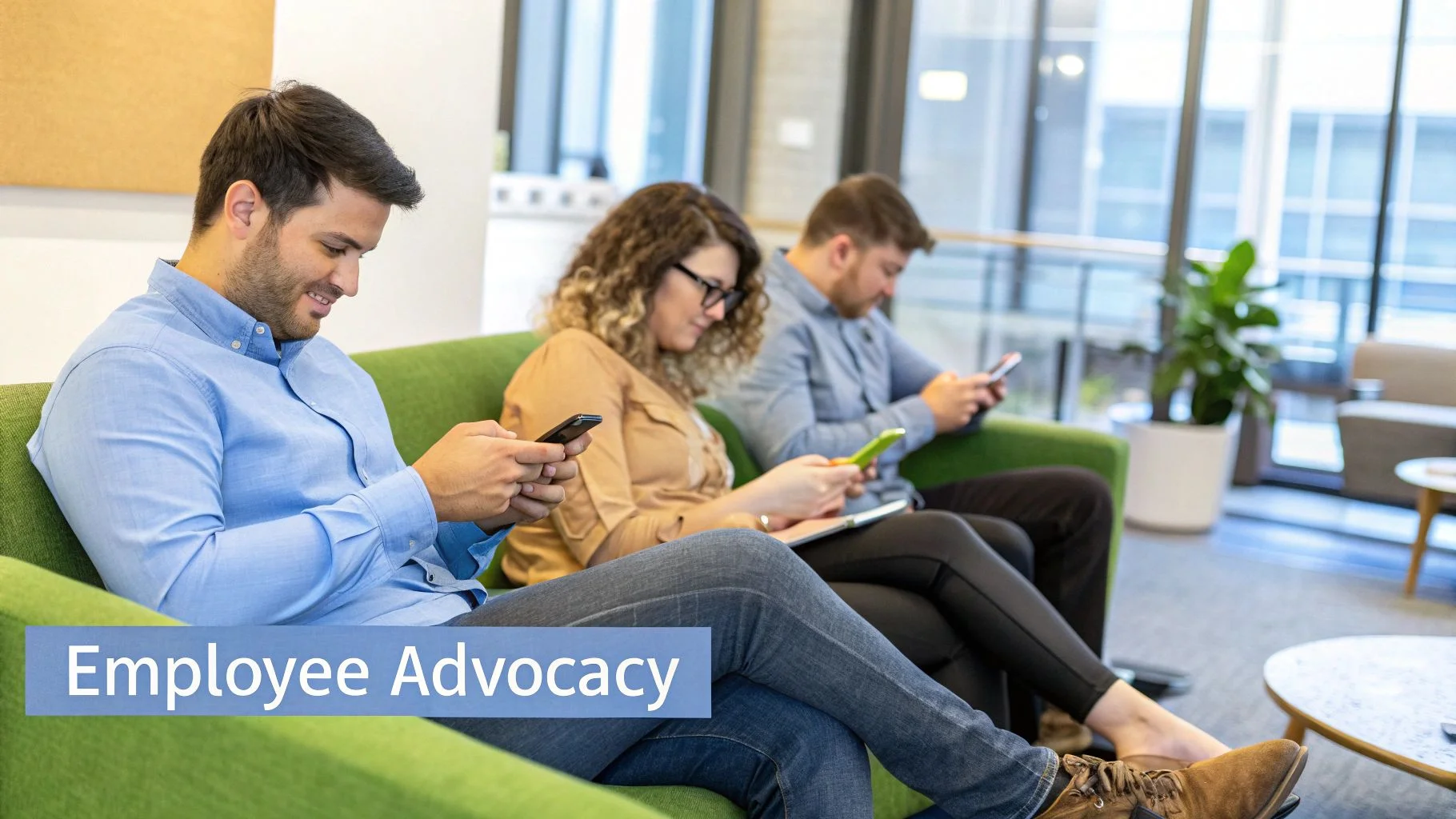Top LinkedIn Marketing Strategies for B2B Success 2025
Discover 8 powerful LinkedIn marketing strategies for B2B growth. Generate leads, build authority, and drive revenue in 2025.

Top LinkedIn Marketing Strategies for B2B Success 2025
In the B2B world, LinkedIn isn't just a digital résumé; it's the epicenter of professional connection, lead generation, and brand authority. Yet, many businesses treat it like a passive directory, missing out on a goldmine of opportunities. The difference between stagnation and exponential growth often lies in a deliberate, multi-faceted approach. A static company page or occasional post simply isn't enough to capture the attention of sophisticated B2B buyers who rely on the platform for industry insights and vendor discovery.
This guide moves beyond the basics, detailing eight powerful and distinct LinkedIn marketing strategies for B2B success. We'll explore how to transform your presence from a simple profile into a dynamic engine for revenue and influence. You will learn practical methods for everything from building unshakeable thought leadership and executing precise advertising campaigns to empowering your entire team through structured advocacy.
Forget surface-level tactics. Each strategy covered provides an actionable framework to generate high-quality leads, foster meaningful engagement, and build a commanding brand presence. Whether your goal is to supercharge your sales pipeline or establish your CEO as an industry icon, these are the blueprints you need to thrive in the competitive B2B landscape.
1. LinkedIn Content Marketing & Thought Leadership
One of the most powerful linkedin marketing strategies for b2b is to transition from a sales-centric approach to becoming a valuable source of industry knowledge. This strategy focuses on consistently creating and distributing insightful, educational content that solves your target audience's problems, positioning your brand and its key people as go-to experts or thought leaders. Instead of directly selling, you build trust and credibility, attracting high-quality prospects who see you as a partner rather than just a vendor.

This approach moves beyond simple company updates. It involves publishing in-depth articles, sharing data-backed trend analyses, and offering practical advice that helps your audience excel in their roles. Companies like Microsoft use this to lead conversations on AI, while HubSpot provides extensive marketing education that naturally generates leads. The goal is to create a magnetic brand presence that draws in decision-makers.
How to Implement This Strategy:
Establish Core Pillars: Identify 3-5 key themes where your company has unique expertise. All content should align with these pillars to build a consistent and recognizable brand voice.
Leverage Native Formats: Go beyond text posts. Use LinkedIn's native features like document carousels (PDFs) to share presentations or reports, and create polls to spark engagement and gather audience insights.
Humanize Your Brand: Encourage executives and subject matter experts to share their personal stories and behind-the-scenes experiences. Authenticity builds a stronger connection than polished corporate-speak.
Optimize for Engagement: Post consistently during peak B2B activity hours (typically Tuesday-Thursday, 8-10 AM). Use 3-5 relevant hashtags to expand your reach and make a point to engage with comments within the first hour to boost your post's visibility in the algorithm.
Key Insight: Thought leadership isn't about having all the answers. It's about asking the right questions and facilitating conversations that move your industry forward. Your content should be the catalyst for these discussions.
This strategy is ideal for B2B companies with complex sales cycles where trust and expertise are paramount. It lays the groundwork for long-term relationships and inbound lead generation. For a deeper dive into building out your content plan, you can explore our detailed guide for creating a winning LinkedIn content strategy.
2. LinkedIn Sales Navigator Prospecting
For B2B sales teams looking to move beyond basic search functions, LinkedIn Sales Navigator is an essential tool that transforms the platform into a powerful prospecting machine. This premium strategy centers on using Sales Navigator's advanced search filters, lead recommendations, and tracking capabilities to identify, engage, and nurture high-value prospects with unparalleled precision. It shifts the focus from broad, untargeted outreach to a highly organized and data-driven sales process.

Unlike standard LinkedIn, Sales Navigator allows you to build and save dynamic lead lists based on granular criteria like company size, seniority level, and recent job changes. Companies like Salesforce and ZoomInfo leverage this to implement sophisticated account-based marketing (ABM) campaigns, pinpointing key decision-makers within target accounts. The tool provides real-time alerts on prospect activity, creating timely opportunities for personalized outreach.
How to Implement This Strategy:
Master Advanced Search: Utilize Boolean operators (AND, OR, NOT) in your searches to create highly specific prospect personas. For example, search for "(VP of Sales) AND (SaaS OR Technology) NOT (Startup)" to refine your results.
Save Leads and Accounts: Actively save promising leads and target accounts to custom lists. This enables you to track their content shares, job changes, and company news, providing valuable context for your outreach.
Personalize InMail Messages: Use the insights gained from a prospect's profile and activity to craft genuinely personalized InMail messages. Reference a recent post they shared or a common connection to significantly increase response rates.
Leverage TeamLink Connections: Use the TeamLink feature to discover if any of your colleagues are connected to a target prospect. A warm introduction through a mutual connection is far more effective than a cold outreach.
Key Insight: The true power of Sales Navigator isn't just finding people; it's understanding the right time and context to connect. Use its intelligence features to turn cold outreach into warm, relevant conversations.
This strategy is indispensable for sales development representatives (SDRs) and account executives whose success depends on building a consistent pipeline of qualified leads. It provides the structure and insights needed for effective, scalable B2B social selling. For a visual guide on getting started, this video offers a practical overview.
3. LinkedIn Advertising & Sponsored Content
While organic strategies build long-term trust, linkedin marketing strategies for b2b often require a paid component to guarantee reach and precision. This approach involves leveraging LinkedIn's powerful advertising platform to target specific B2B audiences with sponsored content, message ads, and dynamic ads. Its key advantage lies in unparalleled professional targeting options, allowing you to filter by job title, company size, industry, and specific skills.

Instead of waiting for your ideal customer to find you, paid ads place your message directly in their feed. For example, Adobe uses sponsored posts to promote Creative Cloud to designers and marketing professionals, while AWS targets IT decision-makers with ads about its cloud migration services. This strategy is essential for lead generation, event promotion, and accelerating pipeline velocity by reaching high-value prospects at scale.
How to Implement This Strategy:
Define Your Objective and Audience: Start in Campaign Manager by choosing a clear goal, such as website visits, lead generation, or brand awareness. Then, build your target audience using LinkedIn’s precise professional demographic data. Create separate campaigns for different buyer personas to ensure ad creative and messaging are highly relevant.
Select the Right Ad Format: Test various formats to see what resonates. Single Image Ads are great for engagement, while Document Ads (PDFs) are effective for sharing case studies or whitepapers. InMail ads can be powerful for direct, personalized outreach but should be used sparingly.
Set a Realistic Budget and Bid: For meaningful data collection, start with a minimum daily budget of around $100. Implement the LinkedIn Insight Tag on your website from day one to track conversions accurately and enable powerful retargeting campaigns.
Optimize and Iterate: Continuously monitor your campaign performance. Analyze your click-through rates (CTR), cost per lead (CPL), and conversion rates. A/B test different headlines, images, and calls-to-action to identify what drives the best results and reallocate your budget accordingly.
Key Insight: LinkedIn advertising is not about broadcasting; it's about precision. The platform's strength is its data. Success comes from layering targeting criteria to create a highly specific audience that perfectly matches your ideal customer profile.
This strategy is ideal for B2B companies with a clearly defined target market and a budget to invest in lead acquisition. It’s perfect for promoting high-value content like webinars and eBooks or driving demo requests. For more on optimizing your campaigns, check out LinkedIn's own best practices.
4. LinkedIn Employee Advocacy Programs
One of the most authentic linkedin marketing strategies for b2b involves turning your employees into brand ambassadors. An employee advocacy program empowers and encourages your team to share company content, industry insights, and professional experiences on their personal LinkedIn profiles. This strategy leverages the collective network of your employees, amplifying your brand's reach and building trust through genuine, human-to-human connections rather than corporate broadcasts.

This approach transforms marketing from a departmental function into a company-wide initiative. Content shared by employees receives significantly higher engagement than content shared by brand pages because it comes from a trusted source. Companies like Cisco and Adobe have demonstrated that these programs can drive massive lead generation and engagement, proving that your team is your most powerful marketing asset.
How to Implement This Strategy:
Provide Ready-to-Share Content: Create a central hub with pre-approved content, including articles, infographics, and videos. Provide suggested captions that employees can easily customize to fit their personal voice.
Train for Success: Don't assume everyone is a LinkedIn expert. Offer training on best practices for profile optimization, content sharing, and professional engagement to build team confidence.
Recognize and Reward Participation: Implement a system to acknowledge top advocates. Gamification, leaderboards, or small incentives can significantly boost motivation and long-term participation.
Measure and Optimize: Use advocacy tools (like Hootsuite Amplify or Sprout Social) or UTM parameters to track the program's impact on key metrics like reach, engagement, website traffic, and lead generation. This data helps you refine your approach.
Key Insight: A successful employee advocacy program isn't about forcing employees to post. It's about creating a culture where they are proud and equipped to share content that aligns with both their professional brand and the company's goals.
This strategy is particularly effective for B2B companies looking to build widespread brand awareness and credibility at scale. It humanizes your brand and taps into networks that your corporate page could never reach alone. To maximize visibility, it's crucial to align employee posts with optimal engagement times, and you can discover more in our guide on the best times to post on LinkedIn.
5. LinkedIn Social Selling
One of the most effective linkedin marketing strategies for b2b is social selling, which transforms the sales process from cold outreach into warm, relationship-driven conversations. This strategy involves sales professionals using LinkedIn to research, connect, and nurture prospects by providing value long before making a sales pitch. Instead of leading with a product demo, you become a trusted advisor by sharing relevant insights and engaging authentically.
This approach humanizes the sales cycle, focusing on building genuine connections. It's about understanding a prospect's challenges and positioning yourself as a helpful resource. Companies like Oracle have successfully used social selling to increase deal sizes, while Microsoft sales reps who leverage this strategy have been shown to achieve significantly higher revenue. The core idea is to sell through relationships, not interruptions.
How to Implement This Strategy:
Optimize Your Profile as a Resource Hub: Treat your LinkedIn profile like a landing page for prospects. Use a professional headshot, a benefit-driven headline, and a summary that speaks directly to your ideal client's pain points.
Share Value, Not Sales Pitches: Consistently post and share content that is helpful to your target audience. This could be industry reports, insightful articles, or quick tips. The goal is to be seen as a source of valuable information.
Engage Before You Connect: Interact with a prospect's posts by liking and leaving thoughtful comments for a period before sending a connection request. This warms up the "cold" outreach and shows genuine interest.
Send Personalized Connection Requests: Avoid generic templates. Reference a shared connection, a recent post they made, or a common group to make your request relevant and more likely to be accepted.
Key Insight: Social selling is a long-term play. The goal isn't an immediate sale; it's to build a network of prospects who trust you, so when they are ready to buy, you are the first person they think of.
This strategy is perfect for sales teams in high-value B2B industries where trust and long-term relationships are critical to closing deals. For a deeper understanding of your performance, you can monitor your progress with LinkedIn’s Social Selling Index (SSI).
6. LinkedIn Company Page Optimization & Engagement
Your LinkedIn Company Page is your digital storefront, and optimizing it is a cornerstone of effective linkedin marketing strategies for b2b. This strategy involves transforming your page from a static profile into a dynamic hub for community engagement, brand storytelling, and lead generation. It’s about creating a compelling and fully-realized brand presence that not only attracts followers but actively engages them and drives measurable business outcomes.
This strategy moves beyond simply having a page; it’s about strategically using every feature to its fullest potential. Companies like Salesforce excel at this by blending thought leadership with vibrant company culture content, while General Electric uses its page to showcase engineering innovations that resonate deeply with its technical audience. The goal is to build an active, engaged community around your brand, making your page a destination rather than just a digital brochure.
How to Implement This Strategy:
Complete and Optimize Your Profile: Fill out every section of your Company Page, including a compelling "About" section with relevant keywords, a custom button (e.g., "Visit website"), and high-quality banner and profile images.
Create a Consistent Content Cadence: Post consistently 2-5 times per week during business hours. Use a mix of formats, including high-quality visuals, native video, and document carousels, to keep your feed fresh and engaging.
Activate Employee Advocacy: Encourage your team to share and engage with company posts. Employee shares significantly amplify reach and add a layer of authenticity, as content from individuals often performs better in the LinkedIn algorithm.
Engage Your Community: Don't just post and ghost. Respond to comments and messages promptly to foster conversation and show that your brand is listening. Use interactive features like polls and questions to actively solicit audience participation.
Key Insight: Your Company Page is most powerful when it serves as a central hub amplified by the voices of your employees. Empowering your team to be brand advocates is the fastest way to scale your reach and credibility.
This foundational strategy is crucial for any B2B company looking to establish a legitimate and professional presence on LinkedIn. It provides the platform upon which other strategies, like advertising and employee advocacy, are built. For further guidance on expanding your network, explore our tips on how to increase your connections on LinkedIn.
7. LinkedIn Lead Generation Forms & Conversion Campaigns
One of the most direct linkedin marketing strategies for b2b is leveraging LinkedIn’s native Lead Gen Forms to capture high-quality leads with minimal friction. This strategy integrates directly with Sponsored Content, allowing users to express interest in your offer by submitting a form that’s pre-filled with their LinkedIn profile data. Instead of sending traffic to an external landing page where users have to manually enter their details, this seamless process dramatically increases conversion rates for lead magnets like webinars, white papers, and demo requests.
This approach streamlines the path from interest to conversion. Companies like Salesforce use Lead Gen Forms to capture sign-ups for CRM demos directly within the newsfeed, while AWS uses them to generate leads for cloud migration consultations. The key is removing barriers, making it incredibly easy for busy professionals to provide their information and engage with your offer without ever leaving the LinkedIn platform.
How to Implement This Strategy:
Create a Compelling Offer: Your lead magnet must be valuable enough to warrant a user sharing their contact information. Think exclusive reports, webinar registrations, free consultations, or demo requests.
Keep Forms Concise: While LinkedIn pre-fills the data, a shorter form is less intimidating. Aim for 3-5 essential fields like Name, Email, Company, and Job Title to maximize completion rates.
Optimize Your Ad Creative: Your ad's headline, copy, and image must clearly communicate the value of your offer. Use a strong call-to-action (CTA) like "Download Now" or "Register Today" that aligns with the form's purpose.
Integrate with Your CRM: Connect your LinkedIn campaigns to your marketing automation platform or CRM. This ensures instant lead syncing and allows you to trigger automated follow-up sequences, ensuring no lead goes cold.
Key Insight: The power of LinkedIn Lead Gen Forms isn't just the convenience; it's the quality of the data. Because the information is pulled directly from a user's professional profile, you receive more accurate and reliable lead data than you would from manual form fills.
This strategy is perfect for B2B companies focused on demand generation and building a robust sales pipeline. It provides a direct, measurable way to convert audience engagement into actionable leads. To explore the ad formats that work best, you can check out LinkedIn’s official guide on Lead Gen Forms.
8. LinkedIn Groups & Community Engagement
Another highly effective linkedin marketing strategies for b2b is to harness the power of niche communities through LinkedIn Groups. This strategy involves actively participating in relevant industry groups or even creating your own branded community to foster direct engagement with prospects, partners, and clients. Instead of broadcasting content, you engage in focused conversations, answer specific questions, and build a reputation as a helpful, knowledgeable expert within a targeted ecosystem.
This approach is about building relationships through shared interests and professional challenges. For instance, a cybersecurity firm can provide immense value by participating in CIO and IT leadership groups, offering advice on emerging threats. Similarly, software companies often create user groups to foster a sense of community, reduce churn, and identify brand advocates. The goal is to become an integral, trusted member of the conversations that matter most to your ideal customer profile.
How to Implement This Strategy:
Be a Contributor, Not a Promoter: Join a curated list of 10-15 active, relevant groups. Your primary goal should be to add value. Answer questions, share unique insights from your experience, and comment thoughtfully on others' posts before ever sharing your own content.
Start Meaningful Discussions: Don't just reshare your latest blog post. Pose open-ended questions related to industry pain points, or share a third-party article and ask for the community's perspective. This positions you as a discussion facilitator.
Create Your Own Community: Consider creating a proprietary group for customers, partners, or a specific industry niche you serve. This gives you a dedicated space to nurture relationships, gather feedback, and establish deep authority.
Engage Consistently: Dedicate a specific time each week to monitor group activity. Consistent, valuable contributions are more effective than sporadic self-promotion. Use engagement as a natural pathway to connect with active members directly.
Key Insight: LinkedIn Groups are one of the few places on the platform where professionals gather with a specific, shared intent. Tapping into that intent with genuine value, rather than a sales pitch, builds trust at a much faster rate.
This strategy is perfect for B2B companies looking to build authority in a niche market and generate leads through authentic, one-to-one interactions. It is particularly effective for consultants, service providers, and businesses whose expertise is their primary differentiator.
LinkedIn B2B Marketing Strategies Comparison
| Strategy | Implementation Complexity 🔄 | Resource Requirements ⚡ | Expected Outcomes 📊 | Ideal Use Cases 💡 | Key Advantages ⭐ |
|---|---|---|---|---|---|
| LinkedIn Content Marketing & Thought Leadership | Medium to High - consistent content creation and industry expertise needed | High time investment for content production and research | Builds brand authority, attracts qualified prospects, long-term value | B2B brands aiming to establish expertise and organic audience growth | Cost-effective, increases credibility, evergreen content |
| LinkedIn Sales Navigator Prospecting | Medium - learning curve for advanced features and daily usage required | Subscription cost and daily prospecting time | Highly targeted lead identification, higher response rates | Sales teams needing precise, data-driven prospect outreach | Advanced filters, CRM integration, real-time insights |
| LinkedIn Advertising & Sponsored Content | High - complex campaign setup and ongoing budget management | Significant budget for ads and testing | Precise targeting with measurable conversions, fast lead generation | B2B marketers with budget for paid campaigns aiming for quick results | Robust targeting, multiple ad formats, detailed analytics |
| LinkedIn Employee Advocacy Programs | Medium - requires ongoing training and coordination | Time and effort to train and engage employees | Amplified organic reach, improved trust and brand authenticity | Companies wanting authentic, trusted brand amplification via employees | Increases reach 5-10x, improves employee engagement, cost-effective |
| LinkedIn Social Selling | Medium to High - requires patience and consistent daily engagement | Training and time for relationship building | Builds genuine relationships and referral opportunities | Sales professionals focusing on relationship-based sales | Higher conversion rates, trusted advisor positioning |
| LinkedIn Company Page Optimization & Engagement | Medium - ongoing content scheduling and page management | Time for content creation and employee engagement | Central brand hub, improved visibility, recruitment support | Organizations seeking an optimized brand presence on LinkedIn | Enhances credibility, provides analytics, supports recruitment |
| LinkedIn Lead Generation Forms & Conversion Campaigns | High - requires paid campaigns and precise offer setup | Paid ad budget and marketing automation integration | Higher conversion rates via seamless lead capture | Marketers focused on efficient lead capture from LinkedIn ads | Pre-filled forms, reduced abandonment, easy CRM integration |
| LinkedIn Groups & Community Engagement | Medium - time-consuming moderation and active participation | Time for meaningful engagement and group management | Builds relationships and credibility in niche communities | Professionals leveraging networking and thought leadership | Access to targeted audiences, free method, builds trust |
Bringing It All Together: Your Integrated LinkedIn Game Plan
Mastering LinkedIn for B2B growth isn't about choosing a single, perfect tactic. It's about building a powerful, interconnected system where each strategy amplifies the others. The most effective LinkedIn marketing strategies for B2B are never executed in isolation; they are woven together to create a cohesive and compounding engine for brand visibility, lead generation, and revenue.
Think of it this way: your thought leadership content (Strategy #1) provides the fuel for your social selling conversations (Strategy #5). An optimized Company Page (Strategy #6) acts as the central hub, giving credibility to your Sales Navigator prospecting (Strategy #2) and providing a strong landing point for your sponsored advertising campaigns (Strategy #3). When you empower your team through an employee advocacy program (Strategy #4), they extend the reach of every piece of content and every campaign you launch, creating an exponential effect.
From Strategy to Action: Your Next Steps
The key takeaway is this: integration is your ultimate advantage. A siloed approach will always yield limited results. A disjointed effort where your sales team uses one message while your marketing team promotes another will confuse prospects and weaken your brand. To move forward effectively, you need a unified game plan.
Start by identifying your primary business objective. Is it lead generation? Brand awareness? Sales pipeline creation? Once you have clarity, select two or three strategies from this guide that directly support that goal.
For Lead Generation: Combine LinkedIn Lead Gen Forms (#7) with highly targeted Sponsored Content (#3) and follow up using Sales Navigator (#2).
For Brand Awareness: Focus on producing high-value Thought Leadership Content (#1) and amplify its reach with a structured Employee Advocacy program (#4).
For Community Building: Actively engage in LinkedIn Groups (#8) while consistently optimizing your Company Page (#6) to serve as a resource hub.
The Power of Consistent, Strategic Action
Ultimately, success on LinkedIn comes down to consistency. Sporadic posting, random connection requests, and occasional ad campaigns will not build the momentum needed to stand out in a crowded professional landscape. The true power lies in showing up every day, providing value, and engaging in meaningful conversations. By thoughtfully combining these LinkedIn marketing strategies for B2B, you transform your presence from a simple online resume into a dynamic, relationship-building powerhouse. This integrated approach is what separates industry leaders from the noise and turns your LinkedIn activity into a predictable and scalable driver of business growth.
Ready to supercharge your daily LinkedIn engagement and make these strategies easier to execute? Social Presence uses AI to help you write insightful comments, manage your outreach, and track your activity, saving you hours each week. Start building meaningful connections faster with Social Presence.